Mental Health Nursing: Collaborative Working and Health Factors
VerifiedAdded on 2023/04/22
|15
|4341
|205
Essay
AI Summary
This essay examines the case of a 45-year-old woman, Teresa, admitted to a community hospital with a history of depression and smoking habits. The essay explores collaborative and shared decision-making principles in healthcare, emphasizing patient-centered care and the roles of healthcare professionals. It delves into factors influencing the physical health of patients with depression, including lifestyle, socio-economic, and environmental factors. Furthermore, it discusses psychopharmacology, particularly the use of antidepressants like SSRIs, and the importance of treatment adherence. The essay also appraises the role of nurses in supporting healthy lifestyle choices, promoting behavior change through education, counseling, and addressing obstacles to patient well-being. The importance of shared decision-making and collaborative working in achieving optimal patient outcomes is highlighted throughout the essay.
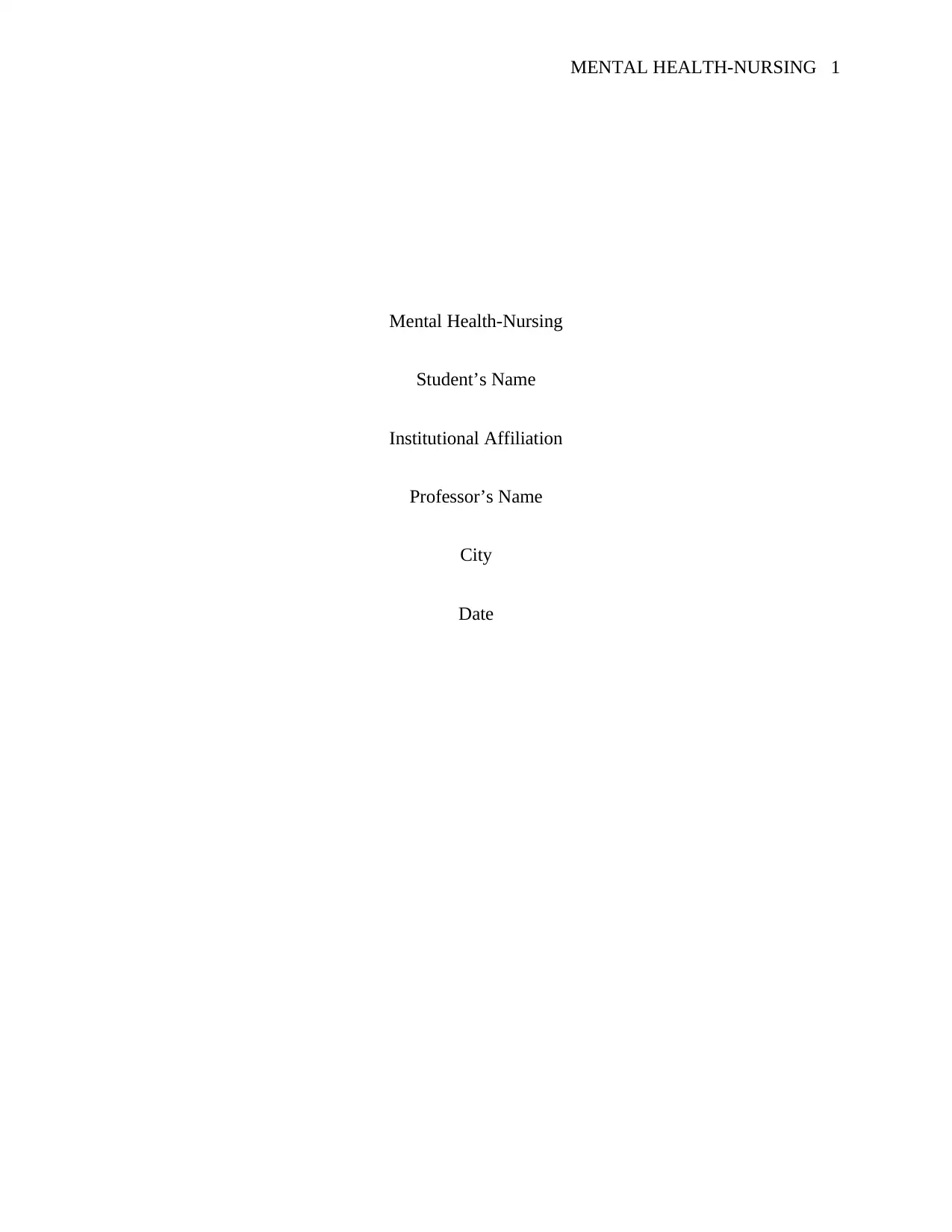
MENTAL HEALTH-NURSING 1
Mental Health-Nursing
Student’s Name
Institutional Affiliation
Professor’s Name
City
Date
Mental Health-Nursing
Student’s Name
Institutional Affiliation
Professor’s Name
City
Date
Paraphrase This Document
Need a fresh take? Get an instant paraphrase of this document with our AI Paraphraser
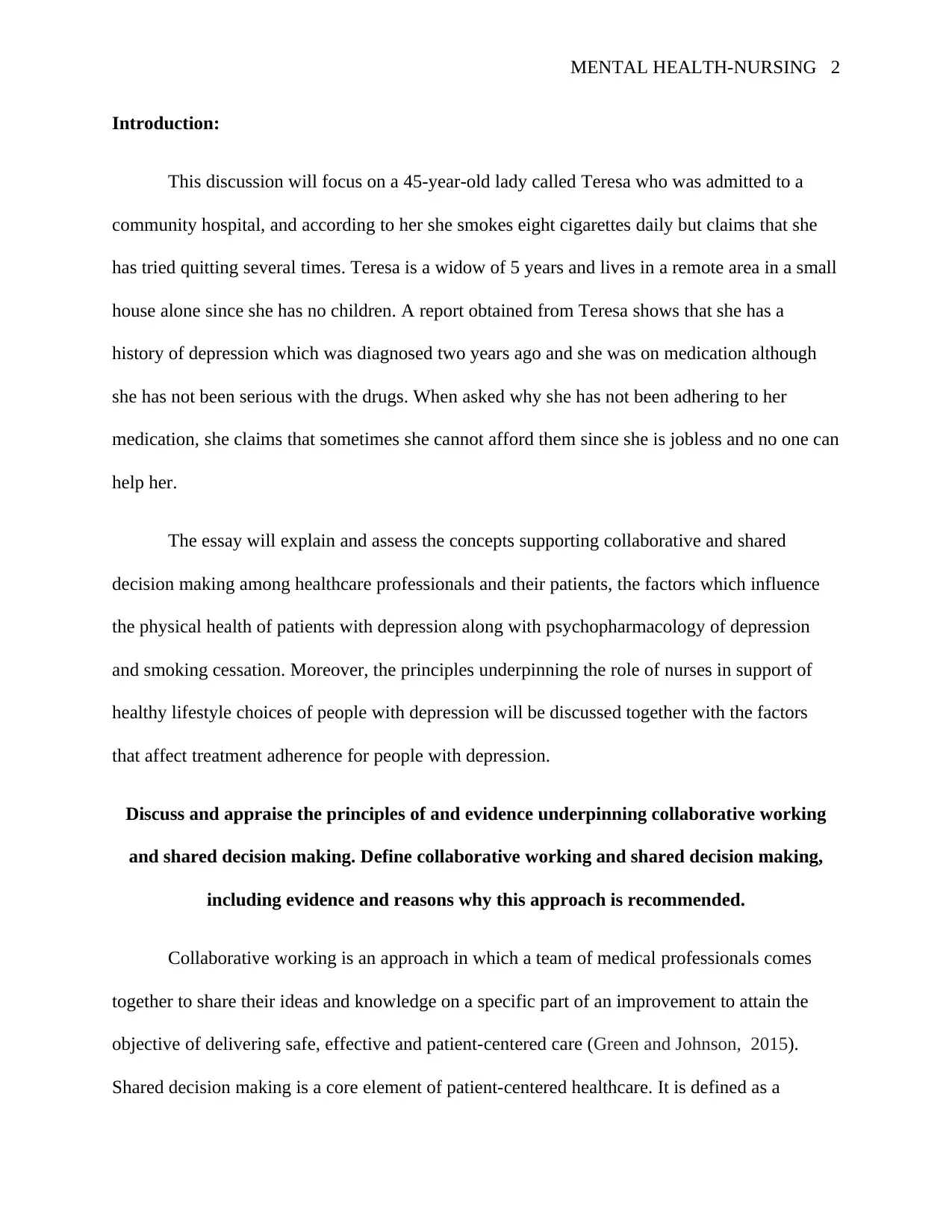
MENTAL HEALTH-NURSING 2
Introduction:
This discussion will focus on a 45-year-old lady called Teresa who was admitted to a
community hospital, and according to her she smokes eight cigarettes daily but claims that she
has tried quitting several times. Teresa is a widow of 5 years and lives in a remote area in a small
house alone since she has no children. A report obtained from Teresa shows that she has a
history of depression which was diagnosed two years ago and she was on medication although
she has not been serious with the drugs. When asked why she has not been adhering to her
medication, she claims that sometimes she cannot afford them since she is jobless and no one can
help her.
The essay will explain and assess the concepts supporting collaborative and shared
decision making among healthcare professionals and their patients, the factors which influence
the physical health of patients with depression along with psychopharmacology of depression
and smoking cessation. Moreover, the principles underpinning the role of nurses in support of
healthy lifestyle choices of people with depression will be discussed together with the factors
that affect treatment adherence for people with depression.
Discuss and appraise the principles of and evidence underpinning collaborative working
and shared decision making. Define collaborative working and shared decision making,
including evidence and reasons why this approach is recommended.
Collaborative working is an approach in which a team of medical professionals comes
together to share their ideas and knowledge on a specific part of an improvement to attain the
objective of delivering safe, effective and patient-centered care (Green and Johnson, 2015).
Shared decision making is a core element of patient-centered healthcare. It is defined as a
Introduction:
This discussion will focus on a 45-year-old lady called Teresa who was admitted to a
community hospital, and according to her she smokes eight cigarettes daily but claims that she
has tried quitting several times. Teresa is a widow of 5 years and lives in a remote area in a small
house alone since she has no children. A report obtained from Teresa shows that she has a
history of depression which was diagnosed two years ago and she was on medication although
she has not been serious with the drugs. When asked why she has not been adhering to her
medication, she claims that sometimes she cannot afford them since she is jobless and no one can
help her.
The essay will explain and assess the concepts supporting collaborative and shared
decision making among healthcare professionals and their patients, the factors which influence
the physical health of patients with depression along with psychopharmacology of depression
and smoking cessation. Moreover, the principles underpinning the role of nurses in support of
healthy lifestyle choices of people with depression will be discussed together with the factors
that affect treatment adherence for people with depression.
Discuss and appraise the principles of and evidence underpinning collaborative working
and shared decision making. Define collaborative working and shared decision making,
including evidence and reasons why this approach is recommended.
Collaborative working is an approach in which a team of medical professionals comes
together to share their ideas and knowledge on a specific part of an improvement to attain the
objective of delivering safe, effective and patient-centered care (Green and Johnson, 2015).
Shared decision making is a core element of patient-centered healthcare. It is defined as a
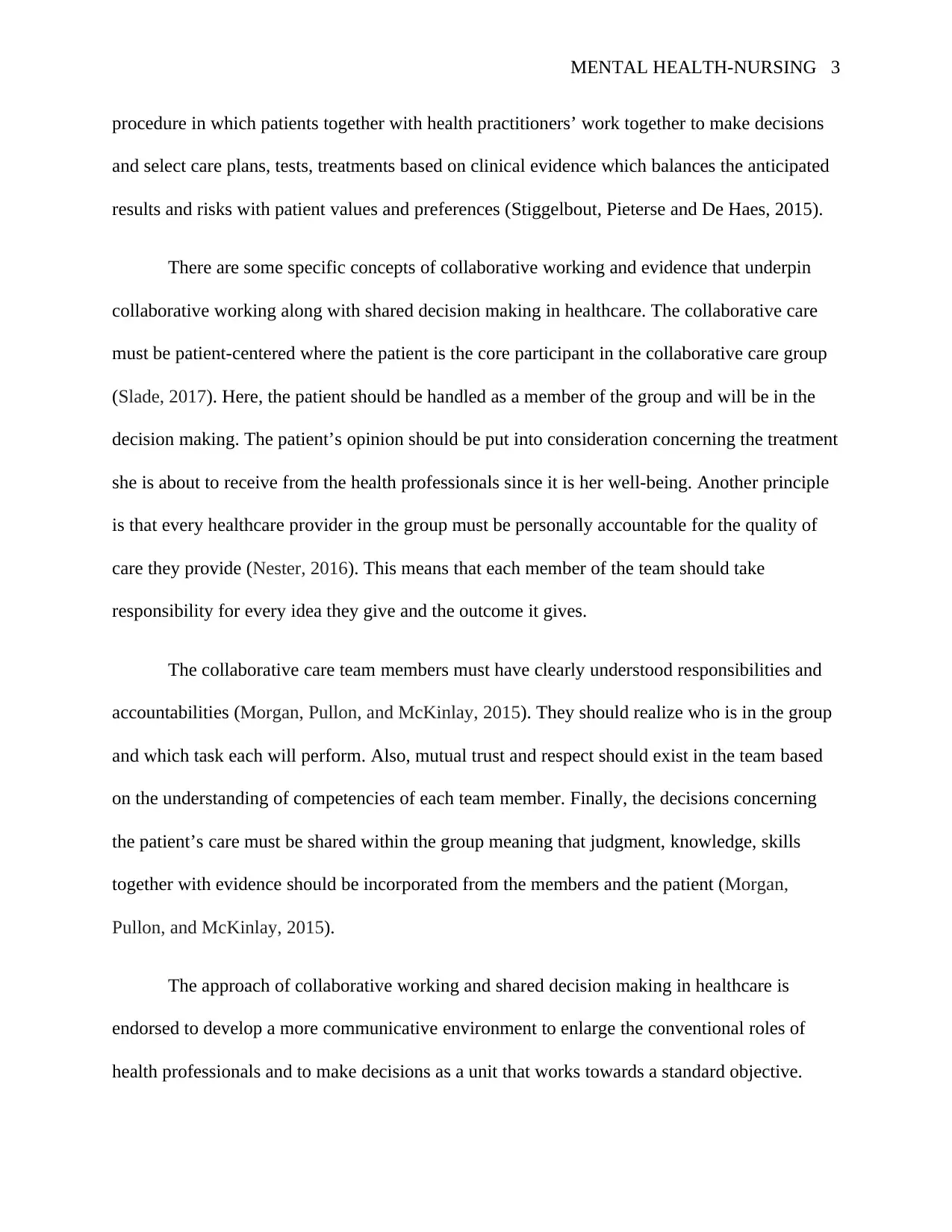
MENTAL HEALTH-NURSING 3
procedure in which patients together with health practitioners’ work together to make decisions
and select care plans, tests, treatments based on clinical evidence which balances the anticipated
results and risks with patient values and preferences (Stiggelbout, Pieterse and De Haes, 2015).
There are some specific concepts of collaborative working and evidence that underpin
collaborative working along with shared decision making in healthcare. The collaborative care
must be patient-centered where the patient is the core participant in the collaborative care group
(Slade, 2017). Here, the patient should be handled as a member of the group and will be in the
decision making. The patient’s opinion should be put into consideration concerning the treatment
she is about to receive from the health professionals since it is her well-being. Another principle
is that every healthcare provider in the group must be personally accountable for the quality of
care they provide (Nester, 2016). This means that each member of the team should take
responsibility for every idea they give and the outcome it gives.
The collaborative care team members must have clearly understood responsibilities and
accountabilities (Morgan, Pullon, and McKinlay, 2015). They should realize who is in the group
and which task each will perform. Also, mutual trust and respect should exist in the team based
on the understanding of competencies of each team member. Finally, the decisions concerning
the patient’s care must be shared within the group meaning that judgment, knowledge, skills
together with evidence should be incorporated from the members and the patient (Morgan,
Pullon, and McKinlay, 2015).
The approach of collaborative working and shared decision making in healthcare is
endorsed to develop a more communicative environment to enlarge the conventional roles of
health professionals and to make decisions as a unit that works towards a standard objective.
procedure in which patients together with health practitioners’ work together to make decisions
and select care plans, tests, treatments based on clinical evidence which balances the anticipated
results and risks with patient values and preferences (Stiggelbout, Pieterse and De Haes, 2015).
There are some specific concepts of collaborative working and evidence that underpin
collaborative working along with shared decision making in healthcare. The collaborative care
must be patient-centered where the patient is the core participant in the collaborative care group
(Slade, 2017). Here, the patient should be handled as a member of the group and will be in the
decision making. The patient’s opinion should be put into consideration concerning the treatment
she is about to receive from the health professionals since it is her well-being. Another principle
is that every healthcare provider in the group must be personally accountable for the quality of
care they provide (Nester, 2016). This means that each member of the team should take
responsibility for every idea they give and the outcome it gives.
The collaborative care team members must have clearly understood responsibilities and
accountabilities (Morgan, Pullon, and McKinlay, 2015). They should realize who is in the group
and which task each will perform. Also, mutual trust and respect should exist in the team based
on the understanding of competencies of each team member. Finally, the decisions concerning
the patient’s care must be shared within the group meaning that judgment, knowledge, skills
together with evidence should be incorporated from the members and the patient (Morgan,
Pullon, and McKinlay, 2015).
The approach of collaborative working and shared decision making in healthcare is
endorsed to develop a more communicative environment to enlarge the conventional roles of
health professionals and to make decisions as a unit that works towards a standard objective.
⊘ This is a preview!⊘
Do you want full access?
Subscribe today to unlock all pages.

Trusted by 1+ million students worldwide
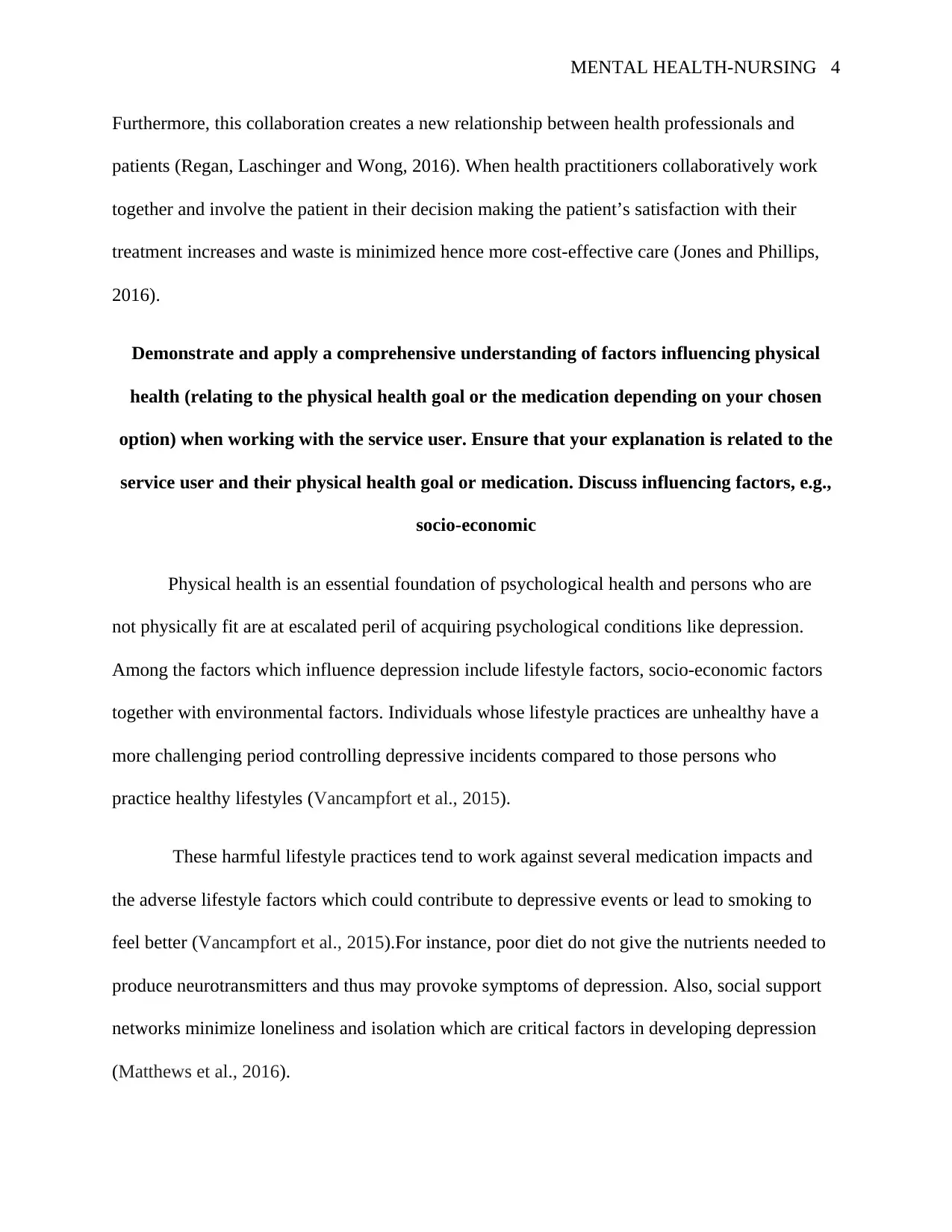
MENTAL HEALTH-NURSING 4
Furthermore, this collaboration creates a new relationship between health professionals and
patients (Regan, Laschinger and Wong, 2016). When health practitioners collaboratively work
together and involve the patient in their decision making the patient’s satisfaction with their
treatment increases and waste is minimized hence more cost-effective care (Jones and Phillips,
2016).
Demonstrate and apply a comprehensive understanding of factors influencing physical
health (relating to the physical health goal or the medication depending on your chosen
option) when working with the service user. Ensure that your explanation is related to the
service user and their physical health goal or medication. Discuss influencing factors, e.g.,
socio-economic
Physical health is an essential foundation of psychological health and persons who are
not physically fit are at escalated peril of acquiring psychological conditions like depression.
Among the factors which influence depression include lifestyle factors, socio-economic factors
together with environmental factors. Individuals whose lifestyle practices are unhealthy have a
more challenging period controlling depressive incidents compared to those persons who
practice healthy lifestyles (Vancampfort et al., 2015).
These harmful lifestyle practices tend to work against several medication impacts and
the adverse lifestyle factors which could contribute to depressive events or lead to smoking to
feel better (Vancampfort et al., 2015).For instance, poor diet do not give the nutrients needed to
produce neurotransmitters and thus may provoke symptoms of depression. Also, social support
networks minimize loneliness and isolation which are critical factors in developing depression
(Matthews et al., 2016).
Furthermore, this collaboration creates a new relationship between health professionals and
patients (Regan, Laschinger and Wong, 2016). When health practitioners collaboratively work
together and involve the patient in their decision making the patient’s satisfaction with their
treatment increases and waste is minimized hence more cost-effective care (Jones and Phillips,
2016).
Demonstrate and apply a comprehensive understanding of factors influencing physical
health (relating to the physical health goal or the medication depending on your chosen
option) when working with the service user. Ensure that your explanation is related to the
service user and their physical health goal or medication. Discuss influencing factors, e.g.,
socio-economic
Physical health is an essential foundation of psychological health and persons who are
not physically fit are at escalated peril of acquiring psychological conditions like depression.
Among the factors which influence depression include lifestyle factors, socio-economic factors
together with environmental factors. Individuals whose lifestyle practices are unhealthy have a
more challenging period controlling depressive incidents compared to those persons who
practice healthy lifestyles (Vancampfort et al., 2015).
These harmful lifestyle practices tend to work against several medication impacts and
the adverse lifestyle factors which could contribute to depressive events or lead to smoking to
feel better (Vancampfort et al., 2015).For instance, poor diet do not give the nutrients needed to
produce neurotransmitters and thus may provoke symptoms of depression. Also, social support
networks minimize loneliness and isolation which are critical factors in developing depression
(Matthews et al., 2016).
Paraphrase This Document
Need a fresh take? Get an instant paraphrase of this document with our AI Paraphraser
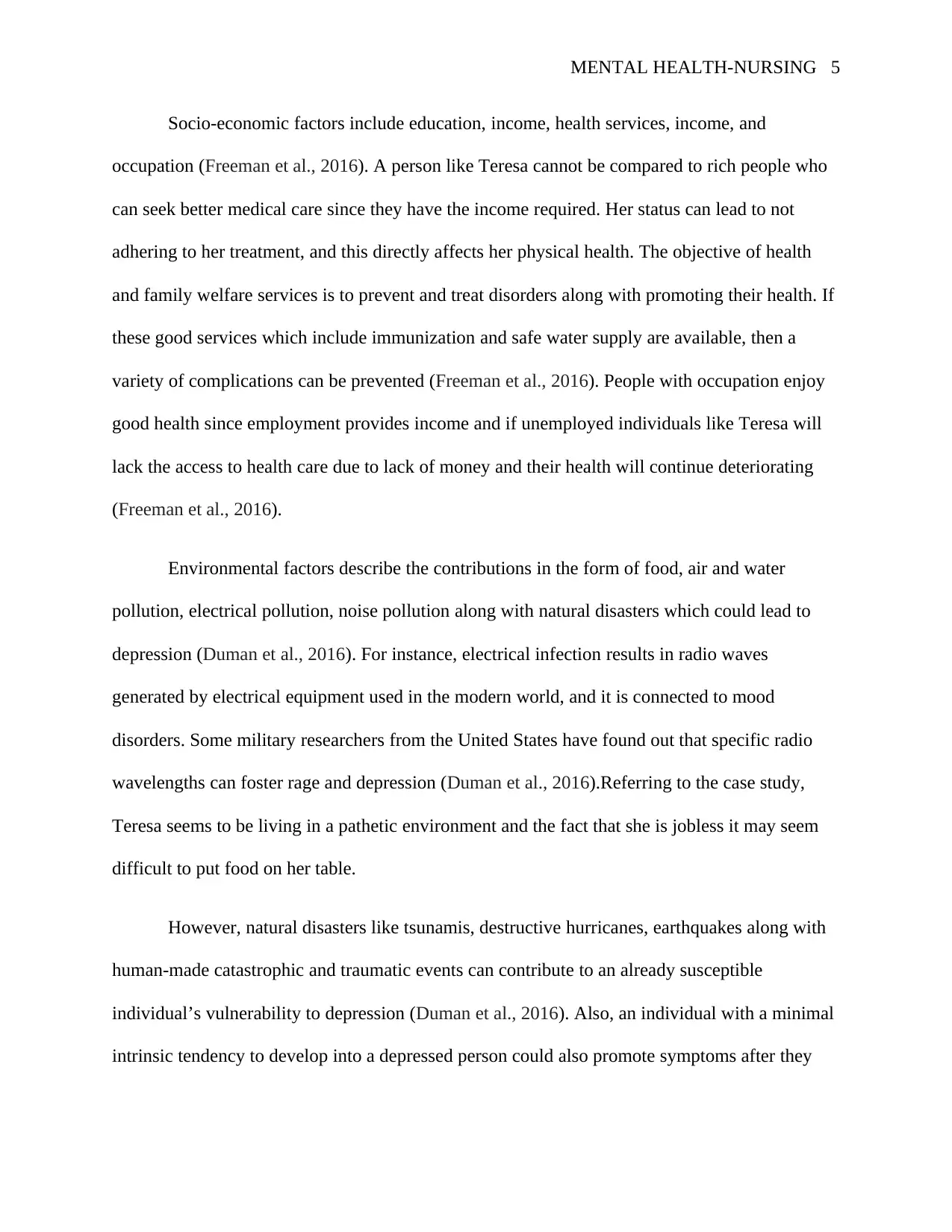
MENTAL HEALTH-NURSING 5
Socio-economic factors include education, income, health services, income, and
occupation (Freeman et al., 2016). A person like Teresa cannot be compared to rich people who
can seek better medical care since they have the income required. Her status can lead to not
adhering to her treatment, and this directly affects her physical health. The objective of health
and family welfare services is to prevent and treat disorders along with promoting their health. If
these good services which include immunization and safe water supply are available, then a
variety of complications can be prevented (Freeman et al., 2016). People with occupation enjoy
good health since employment provides income and if unemployed individuals like Teresa will
lack the access to health care due to lack of money and their health will continue deteriorating
(Freeman et al., 2016).
Environmental factors describe the contributions in the form of food, air and water
pollution, electrical pollution, noise pollution along with natural disasters which could lead to
depression (Duman et al., 2016). For instance, electrical infection results in radio waves
generated by electrical equipment used in the modern world, and it is connected to mood
disorders. Some military researchers from the United States have found out that specific radio
wavelengths can foster rage and depression (Duman et al., 2016).Referring to the case study,
Teresa seems to be living in a pathetic environment and the fact that she is jobless it may seem
difficult to put food on her table.
However, natural disasters like tsunamis, destructive hurricanes, earthquakes along with
human-made catastrophic and traumatic events can contribute to an already susceptible
individual’s vulnerability to depression (Duman et al., 2016). Also, an individual with a minimal
intrinsic tendency to develop into a depressed person could also promote symptoms after they
Socio-economic factors include education, income, health services, income, and
occupation (Freeman et al., 2016). A person like Teresa cannot be compared to rich people who
can seek better medical care since they have the income required. Her status can lead to not
adhering to her treatment, and this directly affects her physical health. The objective of health
and family welfare services is to prevent and treat disorders along with promoting their health. If
these good services which include immunization and safe water supply are available, then a
variety of complications can be prevented (Freeman et al., 2016). People with occupation enjoy
good health since employment provides income and if unemployed individuals like Teresa will
lack the access to health care due to lack of money and their health will continue deteriorating
(Freeman et al., 2016).
Environmental factors describe the contributions in the form of food, air and water
pollution, electrical pollution, noise pollution along with natural disasters which could lead to
depression (Duman et al., 2016). For instance, electrical infection results in radio waves
generated by electrical equipment used in the modern world, and it is connected to mood
disorders. Some military researchers from the United States have found out that specific radio
wavelengths can foster rage and depression (Duman et al., 2016).Referring to the case study,
Teresa seems to be living in a pathetic environment and the fact that she is jobless it may seem
difficult to put food on her table.
However, natural disasters like tsunamis, destructive hurricanes, earthquakes along with
human-made catastrophic and traumatic events can contribute to an already susceptible
individual’s vulnerability to depression (Duman et al., 2016). Also, an individual with a minimal
intrinsic tendency to develop into a depressed person could also promote symptoms after they
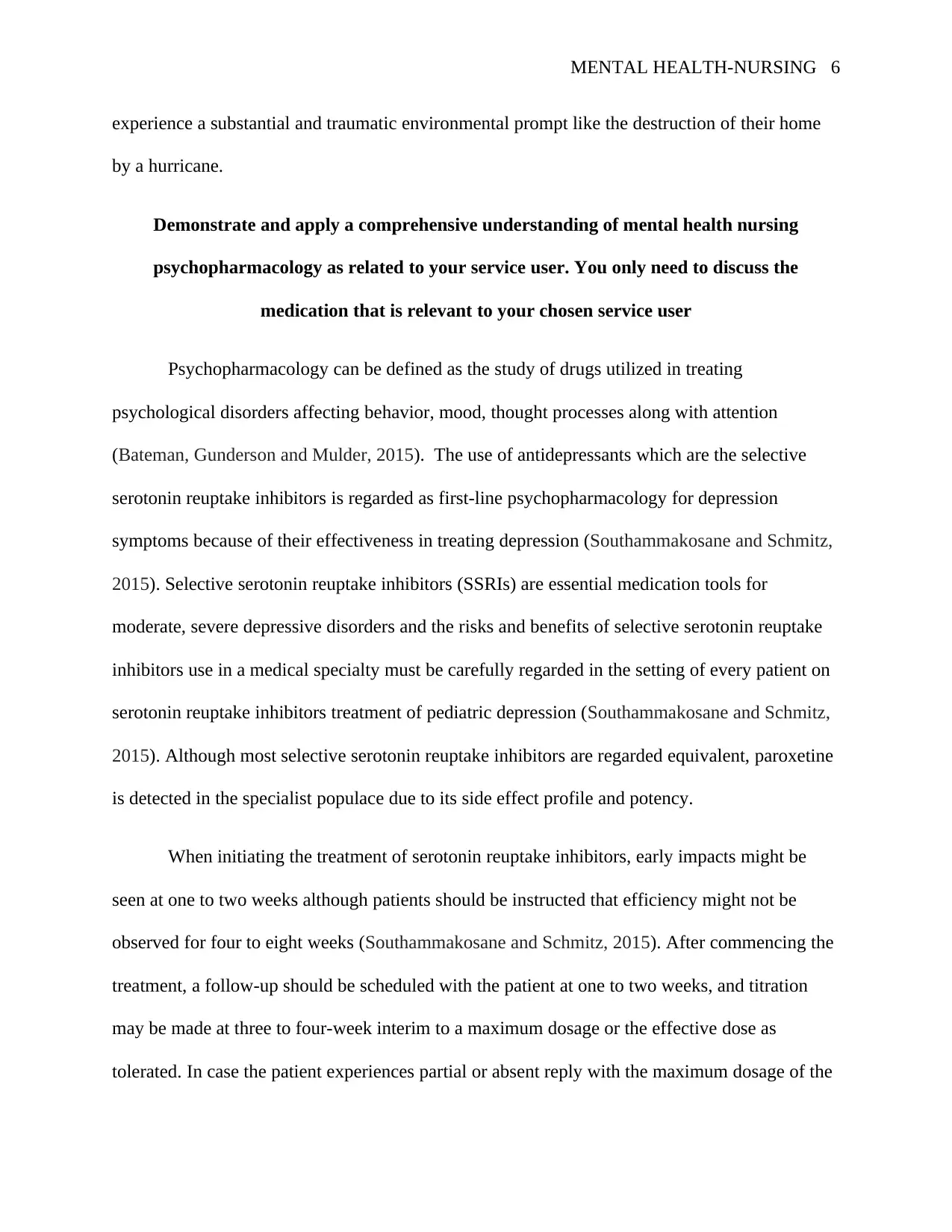
MENTAL HEALTH-NURSING 6
experience a substantial and traumatic environmental prompt like the destruction of their home
by a hurricane.
Demonstrate and apply a comprehensive understanding of mental health nursing
psychopharmacology as related to your service user. You only need to discuss the
medication that is relevant to your chosen service user
Psychopharmacology can be defined as the study of drugs utilized in treating
psychological disorders affecting behavior, mood, thought processes along with attention
(Bateman, Gunderson and Mulder, 2015). The use of antidepressants which are the selective
serotonin reuptake inhibitors is regarded as first-line psychopharmacology for depression
symptoms because of their effectiveness in treating depression (Southammakosane and Schmitz,
2015). Selective serotonin reuptake inhibitors (SSRIs) are essential medication tools for
moderate, severe depressive disorders and the risks and benefits of selective serotonin reuptake
inhibitors use in a medical specialty must be carefully regarded in the setting of every patient on
serotonin reuptake inhibitors treatment of pediatric depression (Southammakosane and Schmitz,
2015). Although most selective serotonin reuptake inhibitors are regarded equivalent, paroxetine
is detected in the specialist populace due to its side effect profile and potency.
When initiating the treatment of serotonin reuptake inhibitors, early impacts might be
seen at one to two weeks although patients should be instructed that efficiency might not be
observed for four to eight weeks (Southammakosane and Schmitz, 2015). After commencing the
treatment, a follow-up should be scheduled with the patient at one to two weeks, and titration
may be made at three to four-week interim to a maximum dosage or the effective dose as
tolerated. In case the patient experiences partial or absent reply with the maximum dosage of the
experience a substantial and traumatic environmental prompt like the destruction of their home
by a hurricane.
Demonstrate and apply a comprehensive understanding of mental health nursing
psychopharmacology as related to your service user. You only need to discuss the
medication that is relevant to your chosen service user
Psychopharmacology can be defined as the study of drugs utilized in treating
psychological disorders affecting behavior, mood, thought processes along with attention
(Bateman, Gunderson and Mulder, 2015). The use of antidepressants which are the selective
serotonin reuptake inhibitors is regarded as first-line psychopharmacology for depression
symptoms because of their effectiveness in treating depression (Southammakosane and Schmitz,
2015). Selective serotonin reuptake inhibitors (SSRIs) are essential medication tools for
moderate, severe depressive disorders and the risks and benefits of selective serotonin reuptake
inhibitors use in a medical specialty must be carefully regarded in the setting of every patient on
serotonin reuptake inhibitors treatment of pediatric depression (Southammakosane and Schmitz,
2015). Although most selective serotonin reuptake inhibitors are regarded equivalent, paroxetine
is detected in the specialist populace due to its side effect profile and potency.
When initiating the treatment of serotonin reuptake inhibitors, early impacts might be
seen at one to two weeks although patients should be instructed that efficiency might not be
observed for four to eight weeks (Southammakosane and Schmitz, 2015). After commencing the
treatment, a follow-up should be scheduled with the patient at one to two weeks, and titration
may be made at three to four-week interim to a maximum dosage or the effective dose as
tolerated. In case the patient experiences partial or absent reply with the maximum dosage of the
⊘ This is a preview!⊘
Do you want full access?
Subscribe today to unlock all pages.

Trusted by 1+ million students worldwide
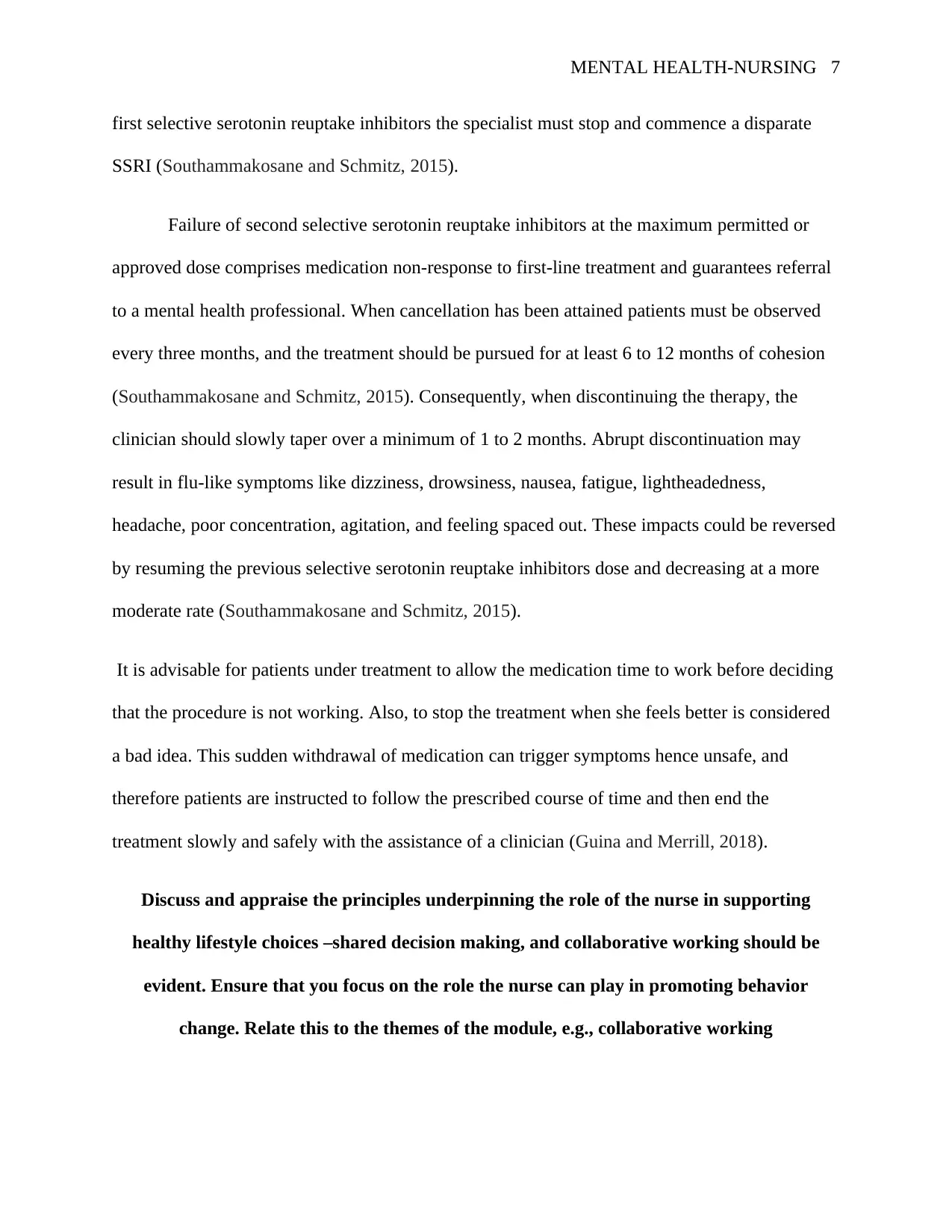
MENTAL HEALTH-NURSING 7
first selective serotonin reuptake inhibitors the specialist must stop and commence a disparate
SSRI (Southammakosane and Schmitz, 2015).
Failure of second selective serotonin reuptake inhibitors at the maximum permitted or
approved dose comprises medication non-response to first-line treatment and guarantees referral
to a mental health professional. When cancellation has been attained patients must be observed
every three months, and the treatment should be pursued for at least 6 to 12 months of cohesion
(Southammakosane and Schmitz, 2015). Consequently, when discontinuing the therapy, the
clinician should slowly taper over a minimum of 1 to 2 months. Abrupt discontinuation may
result in flu-like symptoms like dizziness, drowsiness, nausea, fatigue, lightheadedness,
headache, poor concentration, agitation, and feeling spaced out. These impacts could be reversed
by resuming the previous selective serotonin reuptake inhibitors dose and decreasing at a more
moderate rate (Southammakosane and Schmitz, 2015).
It is advisable for patients under treatment to allow the medication time to work before deciding
that the procedure is not working. Also, to stop the treatment when she feels better is considered
a bad idea. This sudden withdrawal of medication can trigger symptoms hence unsafe, and
therefore patients are instructed to follow the prescribed course of time and then end the
treatment slowly and safely with the assistance of a clinician (Guina and Merrill, 2018).
Discuss and appraise the principles underpinning the role of the nurse in supporting
healthy lifestyle choices –shared decision making, and collaborative working should be
evident. Ensure that you focus on the role the nurse can play in promoting behavior
change. Relate this to the themes of the module, e.g., collaborative working
first selective serotonin reuptake inhibitors the specialist must stop and commence a disparate
SSRI (Southammakosane and Schmitz, 2015).
Failure of second selective serotonin reuptake inhibitors at the maximum permitted or
approved dose comprises medication non-response to first-line treatment and guarantees referral
to a mental health professional. When cancellation has been attained patients must be observed
every three months, and the treatment should be pursued for at least 6 to 12 months of cohesion
(Southammakosane and Schmitz, 2015). Consequently, when discontinuing the therapy, the
clinician should slowly taper over a minimum of 1 to 2 months. Abrupt discontinuation may
result in flu-like symptoms like dizziness, drowsiness, nausea, fatigue, lightheadedness,
headache, poor concentration, agitation, and feeling spaced out. These impacts could be reversed
by resuming the previous selective serotonin reuptake inhibitors dose and decreasing at a more
moderate rate (Southammakosane and Schmitz, 2015).
It is advisable for patients under treatment to allow the medication time to work before deciding
that the procedure is not working. Also, to stop the treatment when she feels better is considered
a bad idea. This sudden withdrawal of medication can trigger symptoms hence unsafe, and
therefore patients are instructed to follow the prescribed course of time and then end the
treatment slowly and safely with the assistance of a clinician (Guina and Merrill, 2018).
Discuss and appraise the principles underpinning the role of the nurse in supporting
healthy lifestyle choices –shared decision making, and collaborative working should be
evident. Ensure that you focus on the role the nurse can play in promoting behavior
change. Relate this to the themes of the module, e.g., collaborative working
Paraphrase This Document
Need a fresh take? Get an instant paraphrase of this document with our AI Paraphraser
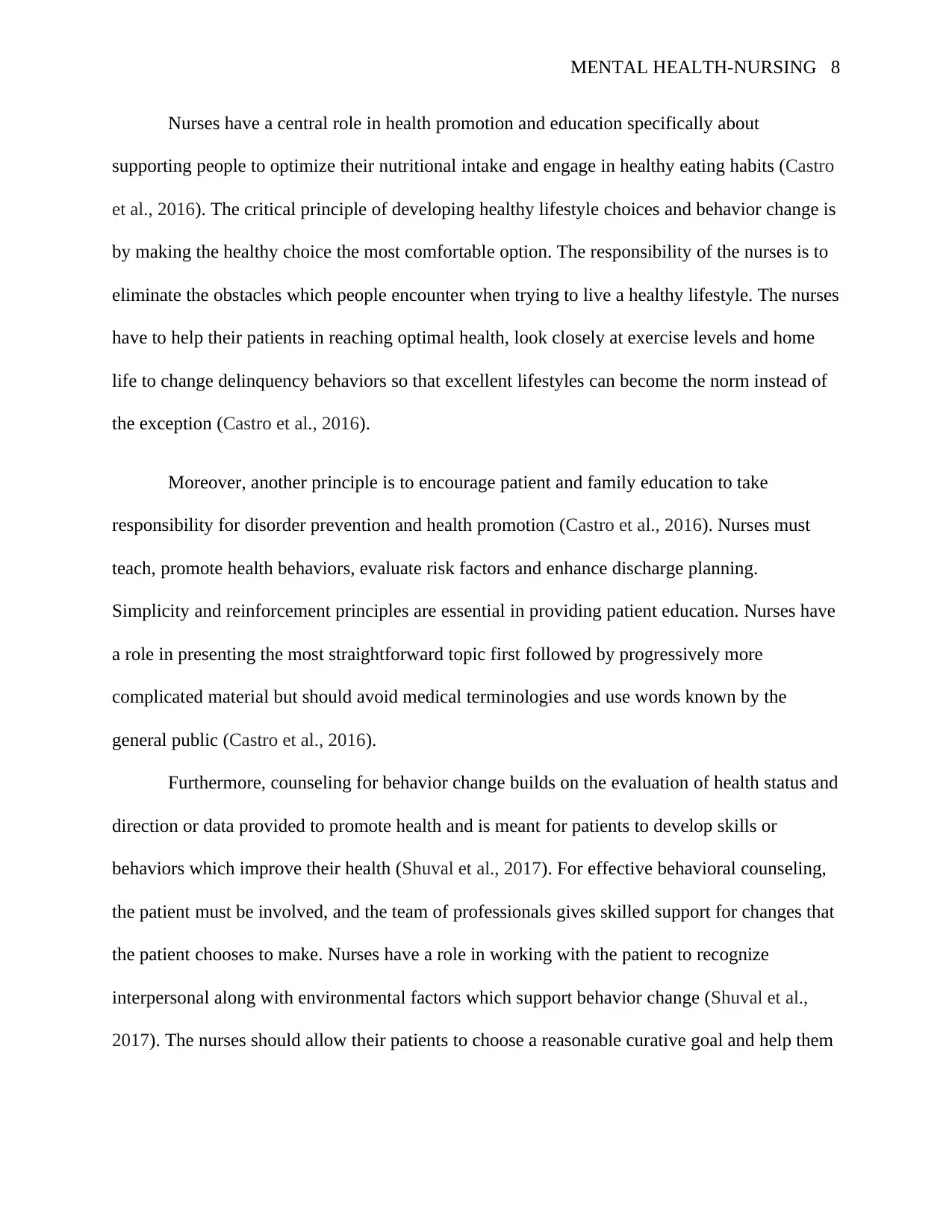
MENTAL HEALTH-NURSING 8
Nurses have a central role in health promotion and education specifically about
supporting people to optimize their nutritional intake and engage in healthy eating habits (Castro
et al., 2016). The critical principle of developing healthy lifestyle choices and behavior change is
by making the healthy choice the most comfortable option. The responsibility of the nurses is to
eliminate the obstacles which people encounter when trying to live a healthy lifestyle. The nurses
have to help their patients in reaching optimal health, look closely at exercise levels and home
life to change delinquency behaviors so that excellent lifestyles can become the norm instead of
the exception (Castro et al., 2016).
Moreover, another principle is to encourage patient and family education to take
responsibility for disorder prevention and health promotion (Castro et al., 2016). Nurses must
teach, promote health behaviors, evaluate risk factors and enhance discharge planning.
Simplicity and reinforcement principles are essential in providing patient education. Nurses have
a role in presenting the most straightforward topic first followed by progressively more
complicated material but should avoid medical terminologies and use words known by the
general public (Castro et al., 2016).
Furthermore, counseling for behavior change builds on the evaluation of health status and
direction or data provided to promote health and is meant for patients to develop skills or
behaviors which improve their health (Shuval et al., 2017). For effective behavioral counseling,
the patient must be involved, and the team of professionals gives skilled support for changes that
the patient chooses to make. Nurses have a role in working with the patient to recognize
interpersonal along with environmental factors which support behavior change (Shuval et al.,
2017). The nurses should allow their patients to choose a reasonable curative goal and help them
Nurses have a central role in health promotion and education specifically about
supporting people to optimize their nutritional intake and engage in healthy eating habits (Castro
et al., 2016). The critical principle of developing healthy lifestyle choices and behavior change is
by making the healthy choice the most comfortable option. The responsibility of the nurses is to
eliminate the obstacles which people encounter when trying to live a healthy lifestyle. The nurses
have to help their patients in reaching optimal health, look closely at exercise levels and home
life to change delinquency behaviors so that excellent lifestyles can become the norm instead of
the exception (Castro et al., 2016).
Moreover, another principle is to encourage patient and family education to take
responsibility for disorder prevention and health promotion (Castro et al., 2016). Nurses must
teach, promote health behaviors, evaluate risk factors and enhance discharge planning.
Simplicity and reinforcement principles are essential in providing patient education. Nurses have
a role in presenting the most straightforward topic first followed by progressively more
complicated material but should avoid medical terminologies and use words known by the
general public (Castro et al., 2016).
Furthermore, counseling for behavior change builds on the evaluation of health status and
direction or data provided to promote health and is meant for patients to develop skills or
behaviors which improve their health (Shuval et al., 2017). For effective behavioral counseling,
the patient must be involved, and the team of professionals gives skilled support for changes that
the patient chooses to make. Nurses have a role in working with the patient to recognize
interpersonal along with environmental factors which support behavior change (Shuval et al.,
2017). The nurses should allow their patients to choose a reasonable curative goal and help them
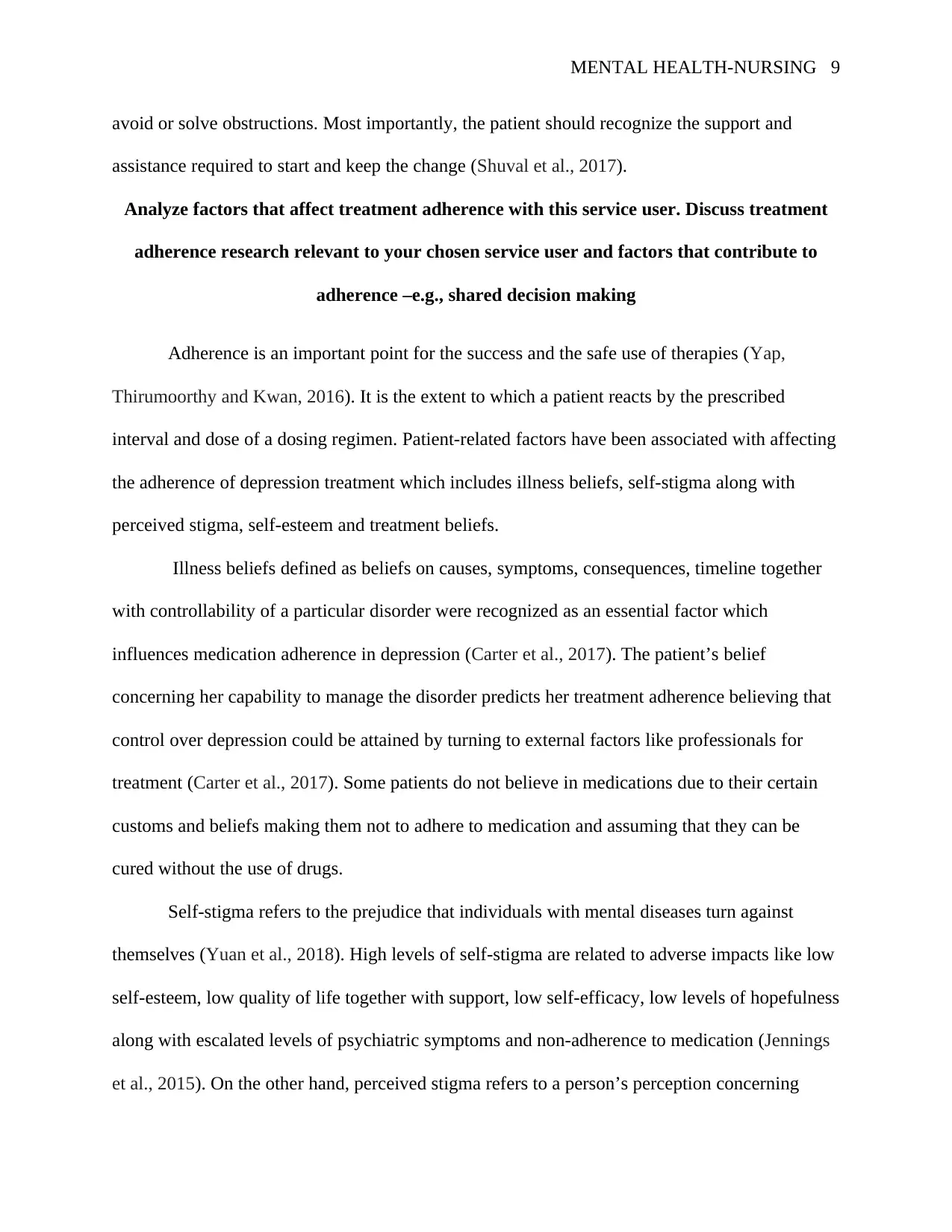
MENTAL HEALTH-NURSING 9
avoid or solve obstructions. Most importantly, the patient should recognize the support and
assistance required to start and keep the change (Shuval et al., 2017).
Analyze factors that affect treatment adherence with this service user. Discuss treatment
adherence research relevant to your chosen service user and factors that contribute to
adherence –e.g., shared decision making
Adherence is an important point for the success and the safe use of therapies (Yap,
Thirumoorthy and Kwan, 2016). It is the extent to which a patient reacts by the prescribed
interval and dose of a dosing regimen. Patient-related factors have been associated with affecting
the adherence of depression treatment which includes illness beliefs, self-stigma along with
perceived stigma, self-esteem and treatment beliefs.
Illness beliefs defined as beliefs on causes, symptoms, consequences, timeline together
with controllability of a particular disorder were recognized as an essential factor which
influences medication adherence in depression (Carter et al., 2017). The patient’s belief
concerning her capability to manage the disorder predicts her treatment adherence believing that
control over depression could be attained by turning to external factors like professionals for
treatment (Carter et al., 2017). Some patients do not believe in medications due to their certain
customs and beliefs making them not to adhere to medication and assuming that they can be
cured without the use of drugs.
Self-stigma refers to the prejudice that individuals with mental diseases turn against
themselves (Yuan et al., 2018). High levels of self-stigma are related to adverse impacts like low
self-esteem, low quality of life together with support, low self-efficacy, low levels of hopefulness
along with escalated levels of psychiatric symptoms and non-adherence to medication (Jennings
et al., 2015). On the other hand, perceived stigma refers to a person’s perception concerning
avoid or solve obstructions. Most importantly, the patient should recognize the support and
assistance required to start and keep the change (Shuval et al., 2017).
Analyze factors that affect treatment adherence with this service user. Discuss treatment
adherence research relevant to your chosen service user and factors that contribute to
adherence –e.g., shared decision making
Adherence is an important point for the success and the safe use of therapies (Yap,
Thirumoorthy and Kwan, 2016). It is the extent to which a patient reacts by the prescribed
interval and dose of a dosing regimen. Patient-related factors have been associated with affecting
the adherence of depression treatment which includes illness beliefs, self-stigma along with
perceived stigma, self-esteem and treatment beliefs.
Illness beliefs defined as beliefs on causes, symptoms, consequences, timeline together
with controllability of a particular disorder were recognized as an essential factor which
influences medication adherence in depression (Carter et al., 2017). The patient’s belief
concerning her capability to manage the disorder predicts her treatment adherence believing that
control over depression could be attained by turning to external factors like professionals for
treatment (Carter et al., 2017). Some patients do not believe in medications due to their certain
customs and beliefs making them not to adhere to medication and assuming that they can be
cured without the use of drugs.
Self-stigma refers to the prejudice that individuals with mental diseases turn against
themselves (Yuan et al., 2018). High levels of self-stigma are related to adverse impacts like low
self-esteem, low quality of life together with support, low self-efficacy, low levels of hopefulness
along with escalated levels of psychiatric symptoms and non-adherence to medication (Jennings
et al., 2015). On the other hand, perceived stigma refers to a person’s perception concerning
⊘ This is a preview!⊘
Do you want full access?
Subscribe today to unlock all pages.

Trusted by 1+ million students worldwide
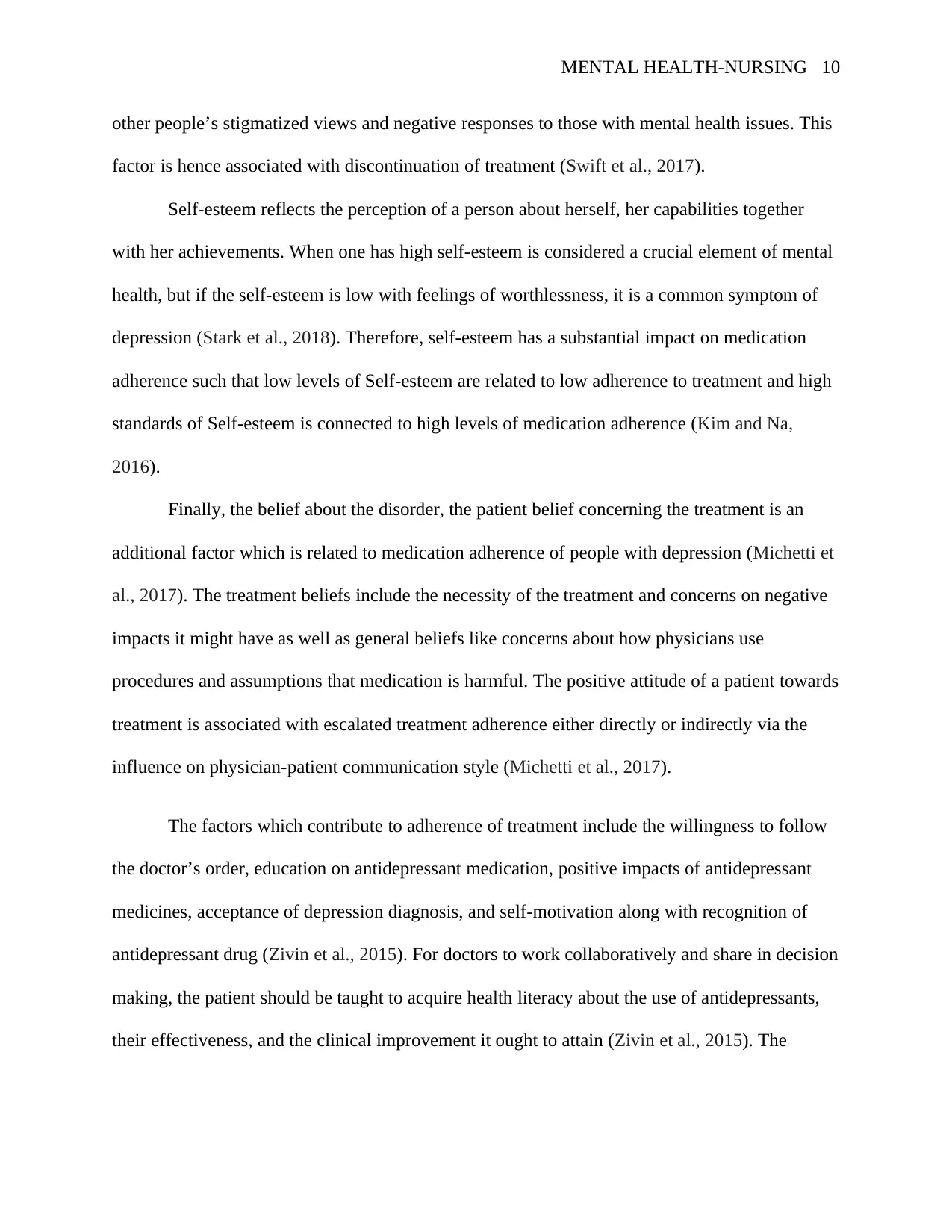
MENTAL HEALTH-NURSING 10
other people’s stigmatized views and negative responses to those with mental health issues. This
factor is hence associated with discontinuation of treatment (Swift et al., 2017).
Self-esteem reflects the perception of a person about herself, her capabilities together
with her achievements. When one has high self-esteem is considered a crucial element of mental
health, but if the self-esteem is low with feelings of worthlessness, it is a common symptom of
depression (Stark et al., 2018). Therefore, self-esteem has a substantial impact on medication
adherence such that low levels of Self-esteem are related to low adherence to treatment and high
standards of Self-esteem is connected to high levels of medication adherence (Kim and Na,
2016).
Finally, the belief about the disorder, the patient belief concerning the treatment is an
additional factor which is related to medication adherence of people with depression (Michetti et
al., 2017). The treatment beliefs include the necessity of the treatment and concerns on negative
impacts it might have as well as general beliefs like concerns about how physicians use
procedures and assumptions that medication is harmful. The positive attitude of a patient towards
treatment is associated with escalated treatment adherence either directly or indirectly via the
influence on physician-patient communication style (Michetti et al., 2017).
The factors which contribute to adherence of treatment include the willingness to follow
the doctor’s order, education on antidepressant medication, positive impacts of antidepressant
medicines, acceptance of depression diagnosis, and self-motivation along with recognition of
antidepressant drug (Zivin et al., 2015). For doctors to work collaboratively and share in decision
making, the patient should be taught to acquire health literacy about the use of antidepressants,
their effectiveness, and the clinical improvement it ought to attain (Zivin et al., 2015). The
other people’s stigmatized views and negative responses to those with mental health issues. This
factor is hence associated with discontinuation of treatment (Swift et al., 2017).
Self-esteem reflects the perception of a person about herself, her capabilities together
with her achievements. When one has high self-esteem is considered a crucial element of mental
health, but if the self-esteem is low with feelings of worthlessness, it is a common symptom of
depression (Stark et al., 2018). Therefore, self-esteem has a substantial impact on medication
adherence such that low levels of Self-esteem are related to low adherence to treatment and high
standards of Self-esteem is connected to high levels of medication adherence (Kim and Na,
2016).
Finally, the belief about the disorder, the patient belief concerning the treatment is an
additional factor which is related to medication adherence of people with depression (Michetti et
al., 2017). The treatment beliefs include the necessity of the treatment and concerns on negative
impacts it might have as well as general beliefs like concerns about how physicians use
procedures and assumptions that medication is harmful. The positive attitude of a patient towards
treatment is associated with escalated treatment adherence either directly or indirectly via the
influence on physician-patient communication style (Michetti et al., 2017).
The factors which contribute to adherence of treatment include the willingness to follow
the doctor’s order, education on antidepressant medication, positive impacts of antidepressant
medicines, acceptance of depression diagnosis, and self-motivation along with recognition of
antidepressant drug (Zivin et al., 2015). For doctors to work collaboratively and share in decision
making, the patient should be taught to acquire health literacy about the use of antidepressants,
their effectiveness, and the clinical improvement it ought to attain (Zivin et al., 2015). The
Paraphrase This Document
Need a fresh take? Get an instant paraphrase of this document with our AI Paraphraser
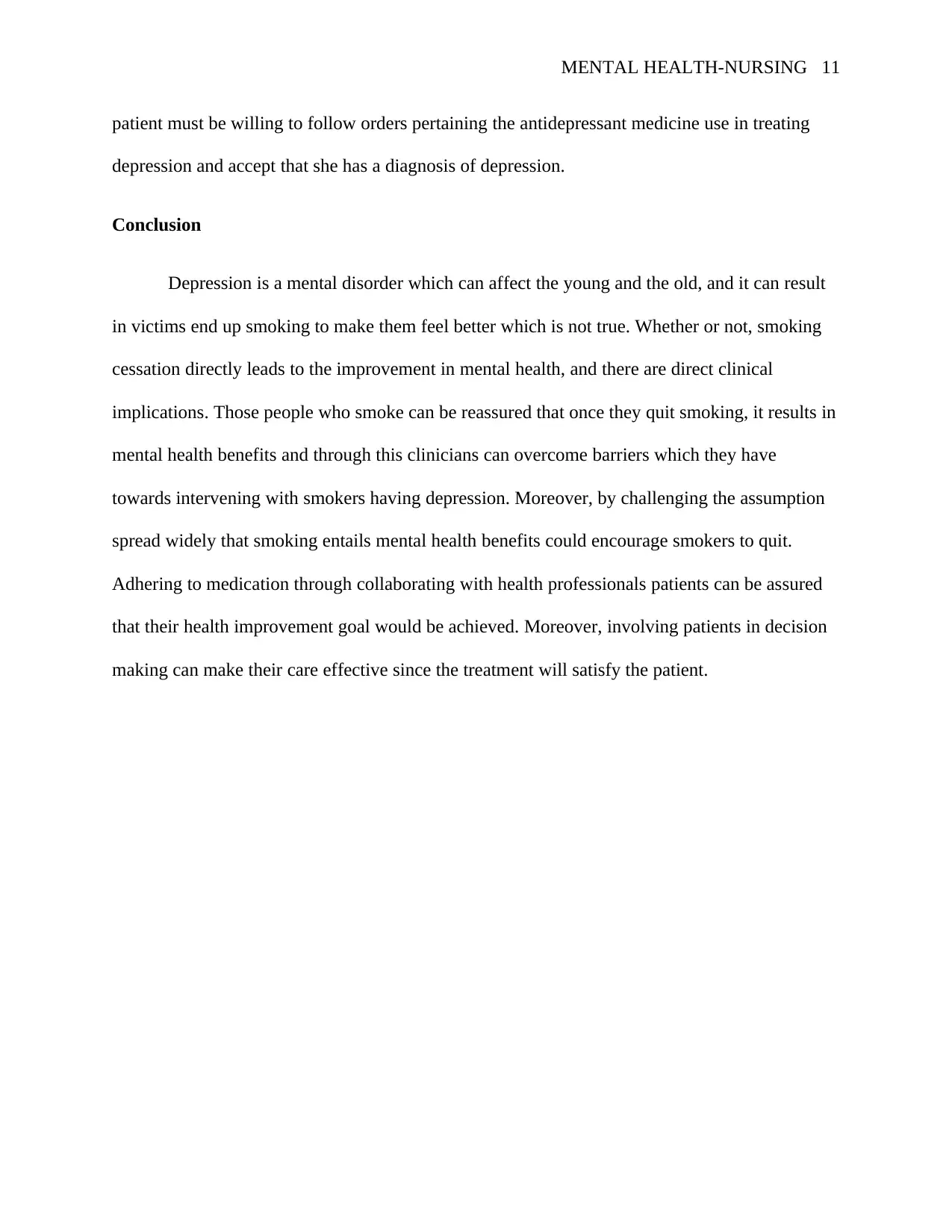
MENTAL HEALTH-NURSING 11
patient must be willing to follow orders pertaining the antidepressant medicine use in treating
depression and accept that she has a diagnosis of depression.
Conclusion
Depression is a mental disorder which can affect the young and the old, and it can result
in victims end up smoking to make them feel better which is not true. Whether or not, smoking
cessation directly leads to the improvement in mental health, and there are direct clinical
implications. Those people who smoke can be reassured that once they quit smoking, it results in
mental health benefits and through this clinicians can overcome barriers which they have
towards intervening with smokers having depression. Moreover, by challenging the assumption
spread widely that smoking entails mental health benefits could encourage smokers to quit.
Adhering to medication through collaborating with health professionals patients can be assured
that their health improvement goal would be achieved. Moreover, involving patients in decision
making can make their care effective since the treatment will satisfy the patient.
patient must be willing to follow orders pertaining the antidepressant medicine use in treating
depression and accept that she has a diagnosis of depression.
Conclusion
Depression is a mental disorder which can affect the young and the old, and it can result
in victims end up smoking to make them feel better which is not true. Whether or not, smoking
cessation directly leads to the improvement in mental health, and there are direct clinical
implications. Those people who smoke can be reassured that once they quit smoking, it results in
mental health benefits and through this clinicians can overcome barriers which they have
towards intervening with smokers having depression. Moreover, by challenging the assumption
spread widely that smoking entails mental health benefits could encourage smokers to quit.
Adhering to medication through collaborating with health professionals patients can be assured
that their health improvement goal would be achieved. Moreover, involving patients in decision
making can make their care effective since the treatment will satisfy the patient.
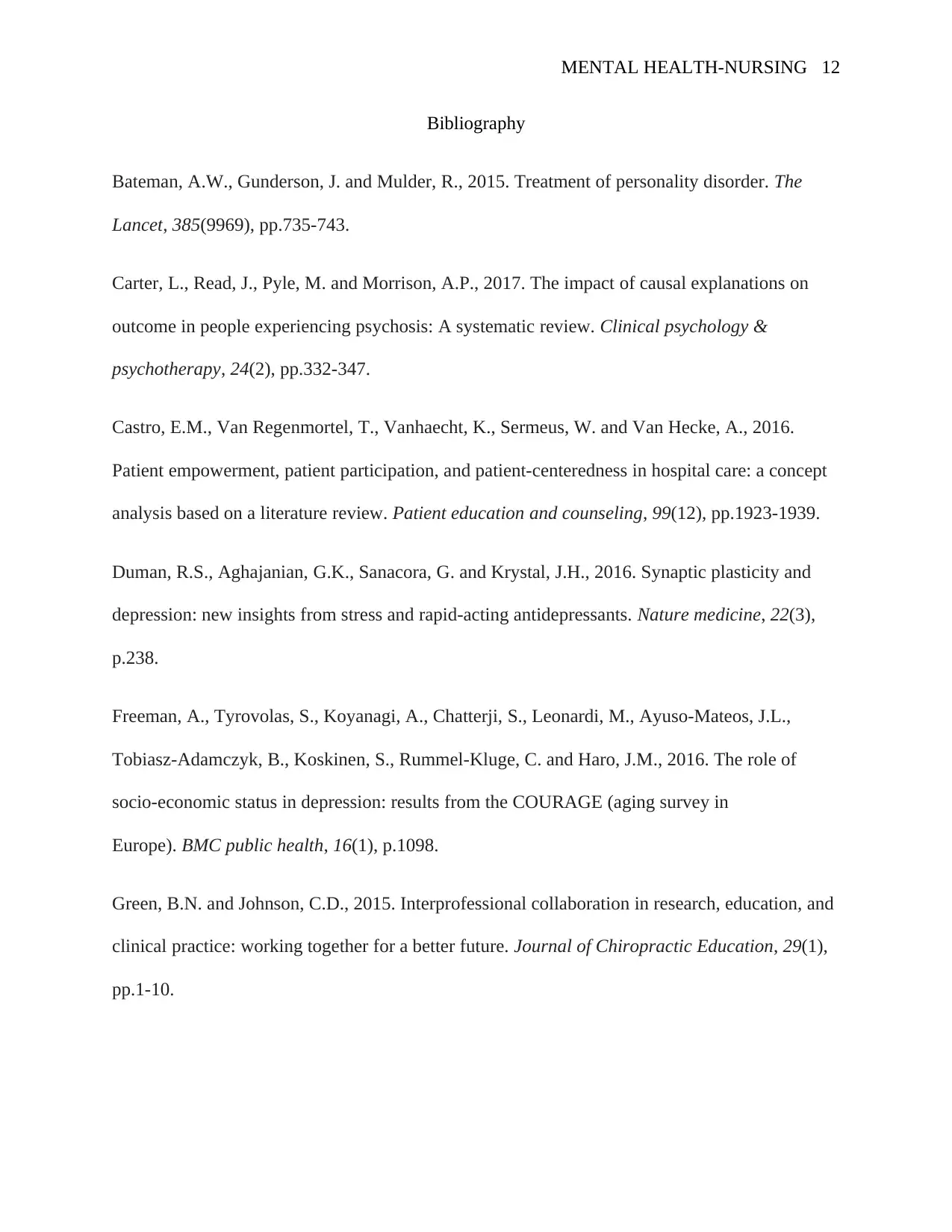
MENTAL HEALTH-NURSING 12
Bibliography
Bateman, A.W., Gunderson, J. and Mulder, R., 2015. Treatment of personality disorder. The
Lancet, 385(9969), pp.735-743.
Carter, L., Read, J., Pyle, M. and Morrison, A.P., 2017. The impact of causal explanations on
outcome in people experiencing psychosis: A systematic review. Clinical psychology &
psychotherapy, 24(2), pp.332-347.
Castro, E.M., Van Regenmortel, T., Vanhaecht, K., Sermeus, W. and Van Hecke, A., 2016.
Patient empowerment, patient participation, and patient-centeredness in hospital care: a concept
analysis based on a literature review. Patient education and counseling, 99(12), pp.1923-1939.
Duman, R.S., Aghajanian, G.K., Sanacora, G. and Krystal, J.H., 2016. Synaptic plasticity and
depression: new insights from stress and rapid-acting antidepressants. Nature medicine, 22(3),
p.238.
Freeman, A., Tyrovolas, S., Koyanagi, A., Chatterji, S., Leonardi, M., Ayuso-Mateos, J.L.,
Tobiasz-Adamczyk, B., Koskinen, S., Rummel-Kluge, C. and Haro, J.M., 2016. The role of
socio-economic status in depression: results from the COURAGE (aging survey in
Europe). BMC public health, 16(1), p.1098.
Green, B.N. and Johnson, C.D., 2015. Interprofessional collaboration in research, education, and
clinical practice: working together for a better future. Journal of Chiropractic Education, 29(1),
pp.1-10.
Bibliography
Bateman, A.W., Gunderson, J. and Mulder, R., 2015. Treatment of personality disorder. The
Lancet, 385(9969), pp.735-743.
Carter, L., Read, J., Pyle, M. and Morrison, A.P., 2017. The impact of causal explanations on
outcome in people experiencing psychosis: A systematic review. Clinical psychology &
psychotherapy, 24(2), pp.332-347.
Castro, E.M., Van Regenmortel, T., Vanhaecht, K., Sermeus, W. and Van Hecke, A., 2016.
Patient empowerment, patient participation, and patient-centeredness in hospital care: a concept
analysis based on a literature review. Patient education and counseling, 99(12), pp.1923-1939.
Duman, R.S., Aghajanian, G.K., Sanacora, G. and Krystal, J.H., 2016. Synaptic plasticity and
depression: new insights from stress and rapid-acting antidepressants. Nature medicine, 22(3),
p.238.
Freeman, A., Tyrovolas, S., Koyanagi, A., Chatterji, S., Leonardi, M., Ayuso-Mateos, J.L.,
Tobiasz-Adamczyk, B., Koskinen, S., Rummel-Kluge, C. and Haro, J.M., 2016. The role of
socio-economic status in depression: results from the COURAGE (aging survey in
Europe). BMC public health, 16(1), p.1098.
Green, B.N. and Johnson, C.D., 2015. Interprofessional collaboration in research, education, and
clinical practice: working together for a better future. Journal of Chiropractic Education, 29(1),
pp.1-10.
⊘ This is a preview!⊘
Do you want full access?
Subscribe today to unlock all pages.

Trusted by 1+ million students worldwide
1 out of 15
Related Documents
Your All-in-One AI-Powered Toolkit for Academic Success.
+13062052269
info@desklib.com
Available 24*7 on WhatsApp / Email
![[object Object]](/_next/static/media/star-bottom.7253800d.svg)
Unlock your academic potential
Copyright © 2020–2025 A2Z Services. All Rights Reserved. Developed and managed by ZUCOL.





